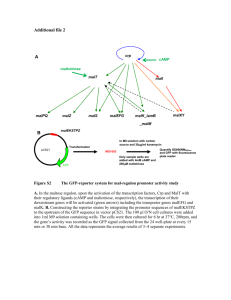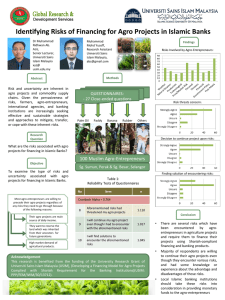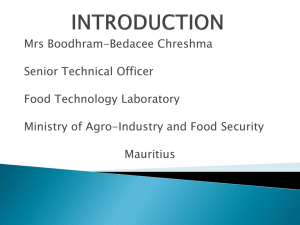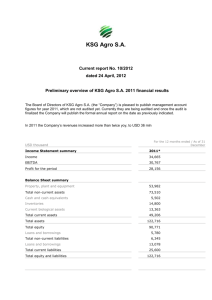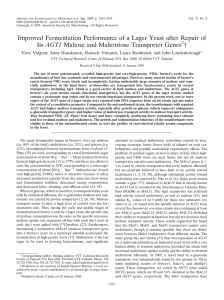Document 14619524
advertisement
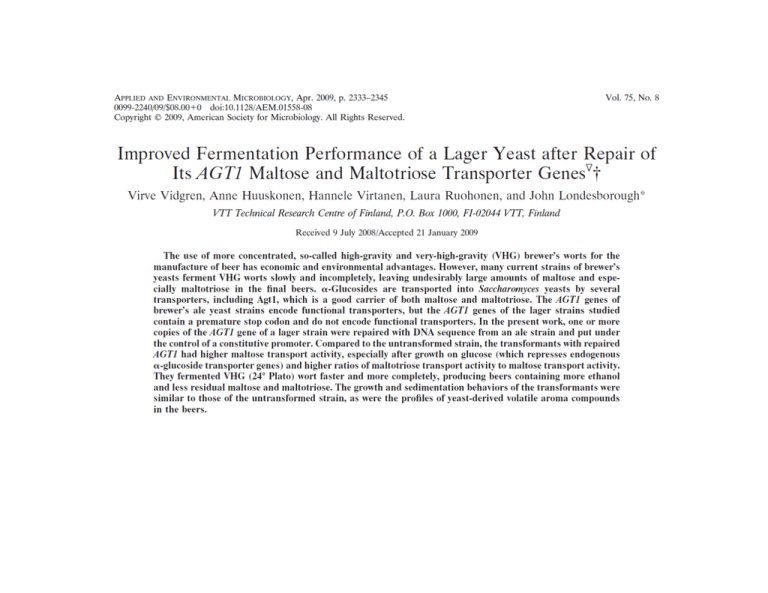
Useful terminology • • • • • • • • Wort (wert)-­‐ un-­‐fermented beer, mostly maltose, maltotriose and glucose (60, 25, and 15%) and tradi?onally obtained from malted barley. Plato (°P)-­‐ expresses concentra?on of extracts (sugars) in wort as percent by weight. 11 °P (100 g wort contains 11 g sugar). 11 °P ≈ 4.5 ABV, 15 °P ≈ 7 ABV, and 24 °P ≈ 11 ABV Apparent a0enua2on-­‐ describes the percent of malt sugar that is converted by yeast (most yeast aMenuate 65 -­‐ 80%) and is determined by comparing the original and final gravi?es of the beer. Organolep2c-­‐ refers to any sensory proper?es of a product, involving taste, color, odor and feel. Ale yeast (Saccharomyces cerevisiae)-­‐ original brewer’s yeast, top fermen?ng, warmer temps. 65-­‐70 °F (18-­‐21 °C). Think Sierra Nevada American Ale Lager yeast (Saccharomyces pastorianus)-­‐ natural hybrid of S. cerevisiae and S. bayanus, boMom fermen?ng, cooler temps. 50-­‐55 °F(10-­‐13 °C). Think Sam Adams Boston Lager Alloploid-­‐ organism with two or more genomes Aneuploid-­‐ unusual number of genes in the same organism Introduc?on • In tradi?onal brewing 11°P wort is used. 17 °P worts are being used, and there is efforts to use very high gravity (VHG) wort. • Advantages: increased produc?on capacity (fermenta?on, storage). Saves energy, labor, water, and cleaning, therefore capital costs. Final beer diluted to a gravity of 7-­‐11°P. Introduc?on • Glucose is used first, and is transported by facilitated diffusion • 85 % of sugars in wort are maltose and maltotriose, which are transported by proton symporters and expression of these transporters is ?ghtly regulated • Maltotriose is the last one to be consumed and residual maltotriose is some?mes undesirable Introduc?on • MALx1 genes (x=1 to 4 and 6) encode maltose transporters • AGT1 a gene 57% iden?cal to MAL11. High ac?vity towards maltotriose as well as to maltose (Km 4-­‐5) • If AGT1 is deleted, maltose is transported, but maltotriose is not • Overexpression of AGT1 in mul?copy plasmid increase maltotriose uptake and fermenta?on • Sequence of AGT1 from eight lager strains contain a one nucleo?de inser?on resul?ng in a premature stop codon encoding a truncated non-­‐func?onal 394 aa polypep?de vs. a full length 616 aa transporter • In all ale yeast strains AGT1 encodes for the full length transporter Objec?ves • Confirm that maltose and maltotriose transport has high level of control over rate and extent of wort fermenta?on • Create a GM lager strain with improved fermenta?on performance containing only Saccharomyces DNA Hypothesis • Repairing defec?ve AGT1 genes of lager strains with DNA sequences from ale strains will accelerate fermenta?on and decrease residual maltotriose levels Characteriza?on of transformants • Integration cassettes to repair one or more copies of AGT1 gene in the lager strain, A15, under the control of a constitutive PGK1 promoter of S. cerevisiae • AGT1 promoter was sequenced from A15 • PGK1 promoter and terminator came from a plasmid • AGT1 from ale strain was PCR amplified Between nucleotides 1 and 317, the sequence of the AGT1 promoter was identical to that of the MAL11 promoter in the SGDB, except for two changes (A for C at 8 and A for G at 152). However, between 318 and 807, the level of identity fell to 35% • The rationale for the selection procedure was that pregrowth on glucose represses endogenous genes for α-glucoside transporters, causing long lag phases before growth on maltotriose when respiration is inhibited with antimycin A . Transformants containing a constitutively expressed maltotriose transporter gene were expected to start growing sooner. • There was no clear difference between the long and short forms of the cassette in the number of colonies recovered. Confirma?on of integra?on • Southern blot analysis with the AGT1 probe was applied to 36 colonies recovered on maltotriose-­‐an?mycin AG418 plates • In 30 colonies, contained both an endogenous AGT1 gene and a transformed AGT1 gene with a PGK1 promoter • Six colonies tested contained only the transformed AGT1 gene (and PGK1 promoter?) • Verified by PCR that the casseMe had integrated into the endogenous AGT1 locus • Confirmed by that integra?on had occurred 3’ to the frameshih of AGT1 of A15 Confirma?on of integra?on Transcrip?onal analysis • Three integrants were selected (1, 2 and 14) • Cured of plasmid pKX34 • Absence of bacterial DNA confirmed by Southern blot • All integrants had at least one na?ve and one (maybe more) repaired ATG1 loci • Expression of genes of interest was measured using TRAC (transcript analysis with aid of affinity capture) • • • • total RNA prepara?on or cell lysate is hybridized simultaneously with a bio?n-­‐ labeled oligo(dT) and a pool of gene-­‐ specific detec?on probes labeled with a fluorescent dye at 3Vand 5Vends (Fig. 1A) mRNA bound to the oligo(dT) is captured with streptavidin coated magne?c beads and nonspecifically bound detec?on probes with other sample material are washed off (Fig. 1B) The specifically bound detec?on probes are eluted from the beads (Fig.1C) and detected in capillary electrophoresis (Fig. 1C) Each detec?on probe, i.e. mRNA under study, is dis?nguished among the pool by its size and quan?fied based on the area of the peak (Fig. 1D) Rautio, et al., 2006 Apparent expression levels α-­‐glucoside transport capacity of integrants • Maltose and maltotriose transport ac?vi?es were measured in cells of each strain (grown on glucose) harvested at 13 h • Strain A15 cells exhibited liMle or no ac?vity (expected, no func?onal AGT1) (they don’t say about the integrants) • Grown on glucose, harvested at near sta?onary: The maltose transport capacity of strain A15 was 1.6 U/g of dry yeast, whereas integrants 1, 2, and 14 exhibited 10.3, 6.6, and 5.1 U/ g of dry yeast • If grown on maltose, no difference in maltose transport (18, 20, 21, 22 U respec?vely) • But maltotriose transport increased from 3.4 U (A15) to 8.5, 5.1, and 5.4 U in integrants 1, 2, and 14 Gene?c stability • Strain A15 and integrants 1, 2, and 14 were cycled 14 ?mes on glucose • Yeast suspensions were diluted and spread on nonselec?ve (20 g of glucose/liter1) and selec?ve (20 g of maltotriose plus 200 mg an?mycin A/liter1) plates • Colonies picked, Southerns performed, obtaining same results as before, therefore integrants were gene?cally stable through 110 genera?ons in non-­‐selec?ve media Gene?c stability Fermenta?on of High Gravity Wort Growth Profiles Organolep?c Profiles Conclusions • Ale-­‐cons?tu?ve ATG1 maltose transporter improves maltose and maltotriose transport and u?liza?on/fermenta?on • Speeds up fermenta?on ?me • Improves ethanol yields and lower apparent final extract • Does not affect organolep?c quali?es in beer • No bacterial DNA is used • Lager MM1 has higher affinity for maltotriose than maltose. Purng MTT1 under cons?tu?ve promoter may improve maltotriose fermenta?on in high gravity worts Beer is proof that God loves us and wants us to be happy!-­‐ Ben Frankin Ques?ons? Effect of alcohols on inactivation of the maltose and galactose transporters Luceroetal1997. Cells were harvested during exponential growth with maltose or galactose (about 0.7 mg [dry weight]/ml), washed, and suspended in 3 volumes of an ammoniumfree medium as described previously (2), with 2% glucose and 250 mg of tetracycline hydrochloride per ml to avoid bacterial contamination and in the absence or presence of alcohols at the indicated concentrations. After incubation at 30°C in a rotatory shaker (200 rpm) for the indicated times, inactivation was monitored by measuring the activity of the transporters by using their labeled substrates (4, 28). The cells were harvested, washed, and suspended to a cellular density of 40 mg (dry weight) of yeast/ml in 0.1 M tartaric acid adjusted to pH 4.2 with Tris in the case of the maltose transporter or 50 mM K2HPO4 (pH 6.0) in the case of the galactose transporter. Aliquots of 50 ml, containing 2 mg (dry weight) of yeast, were added to 5 ml of 45 mM labeled maltose or galactose (0.5 mCi/mmol), respectively, and incubated at 20°C for 15 s. Sugar uptake was stopped by the addition of 10 ml of chilled water. After rapid filtration, the cells and filters were washed with 10 ml of chilled water and immediately submerged in liquid scintillation cocktail, and the radioactivity was counted.
